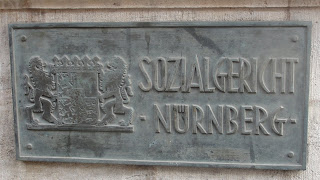 |
| The old inner city of Nuremberg (from when the city was founded in the Middle Ages) was enshrouded by a fearsome city wall. Its many gates were overlooked by these towers. |
 |
| The trains are surprisingly clean and roomy. |
 |
| The new construction of the modern art and design museum is juxtaposed with the centuries-old structures elsewhere in the city. |
 |
| Inside the St. Lorenz cathedral, my first European church. It's pretty awe-inspiring. St. Lorenz is the biggest and most famous church in Nuremberg. |
 |
| One of St. Lorenz's two towers. |
 |
| Looking down the street at St. Lorenz. |
 |
| Inside the cathedral. It's a really incredible sight. |
 |
| Looking up at the organ and stained-glass window. |
 |
| An angel, poised to fight the forces of Hell. |
 |
| My first true Fachwerkhaus! This style is pretty much ubiquitous in Germany (especially Bavaria, where I am), but since it's the first one I saw it was worth the photo. |
 |
| The Pegnitz River that divides Nuremberg. On one side is St. Lorenz cathedral and on the other is St. Sebald. |
 |
| A very old building we toured near the river. It is the social court, not the famous Palace of Justice where the Nuremberg Trials were held. I'm touring that one later. |
 |
| The intricate bas relief above the massive entrance to the St. Lorenz cathedral. The cathedral is under renovation, so it's covered in a net. I don't know how that's supposed to protect it... |
 |
| The above picture is located at the bottom of this one. Here the beautiful window and twin towers are majestically visible. |
 |
| Of course, the fountain itself is nothing to sneeze at! |
 |
| A picture looking up at the Kaiserburg, one of the Kaiser's many castles spread throughout Bavaria. More to come tomorrow! |
 |
| Yet another church, St. Egedien's. |
 |
| Yes, you can get Skittles in Germany, though the Hailands had never heard of them before. |
German Word of the Day / Deutsches Wort des Tages
die Kirche :: church
Heute sah Kapitaen drei verschiedene Kirche.
Today, Kirk saw three different churches.











Kirk, I Loved all the photos and the great history lesson. The school is really beautiful!! Keep them coming!! Love, Mom
ReplyDeleteKirk, just in case you didn't get my first comment: Your photography is just wonderful--and I love all the notations you are including with the pictures. I particularly love the rose window at St. Lorenz. And to think, the school was old by the time the Pilgrims landed at Plymouth Rock!! Keep up the good work! Love, Grandmom
ReplyDelete